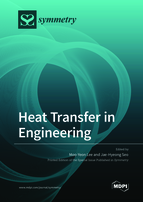Heat Transfer in Engineering
A special issue of Symmetry (ISSN 2073-8994). This special issue belongs to the section "Physics".
Deadline for manuscript submissions: closed (30 June 2021) | Viewed by 31498
Special Issue Editors
Interests: heat transfer; green car; thermal management system
Special Issues, Collections and Topics in MDPI journals
Interests: heat transfer enhancement using ferrofluid; cooling control technology of core power electronics for electric vehicle; battery thermal management system for electric vehicle; theoretical analysis; CFD analysis
Special Issue Information
Dear Colleagues,
This is a call for papers of a Special Issue on “Heat Transfer in Engineering”. The advancements in research related to heat transfer has gathered much attention in recent decades following the quest for efficient thermal systems, interdisciplinary studies involving heat transfer, and energy research. Heat transfer, a fundamental transport phenomenon, has been considered one of the critical aspects for the development and advancement of many modern applications, including cooling, thermal systems which contain symmetry analysis, energy conservation and storage, and symmetry-preserving discretization of heat transfer in a complex turbulent flow. The objective of the Special Issue is to present recent advances as well as up-to-date progress in all areas of heat transfer in engineering and its influence on emerging technologies.
The broad topics of interest include, but not limited to, the following:
- Heat transfer and thermal phenomena at all scales (from nanoscale to macroscale)
- Thermal systems and thermal management systems
- Interdisciplinary study focusing on heat transfer
- Waste heat recovery and allied heat transfer applications
- Heat transfer in energy storage and energy conservation
- Experimental, numerical and analytical studies focusing on heat transfer and thermal phenomena
- Fundamental mechanism and practical applications of heat transfer in wide variety of processes
Dr. Jae-Hyeong Seo
Guest Editors
Manuscript Submission Information
Manuscripts should be submitted online at www.mdpi.com by registering and logging in to this website. Once you are registered, click here to go to the submission form. Manuscripts can be submitted until the deadline. All submissions that pass pre-check are peer-reviewed. Accepted papers will be published continuously in the journal (as soon as accepted) and will be listed together on the special issue website. Research articles, review articles as well as short communications are invited. For planned papers, a title and short abstract (about 100 words) can be sent to the Editorial Office for announcement on this website.
Submitted manuscripts should not have been published previously, nor be under consideration for publication elsewhere (except conference proceedings papers). All manuscripts are thoroughly refereed through a single-blind peer-review process. A guide for authors and other relevant information for submission of manuscripts is available on the Instructions for Authors page. Symmetry is an international peer-reviewed open access monthly journal published by MDPI.
Please visit the Instructions for Authors page before submitting a manuscript. The Article Processing Charge (APC) for publication in this open access journal is 2400 CHF (Swiss Francs). Submitted papers should be well formatted and use good English. Authors may use MDPI's English editing service prior to publication or during author revisions.
Keywords
- heat transfer
- thermal system
- thermal phenomena
- heat transfer applications
- thermal management
- cooling
- thermal transport
- heating
- waste heat recovery
- energy conversion







